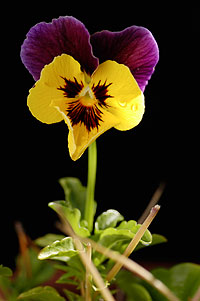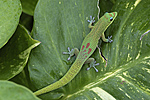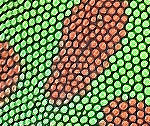last update: 9 January 2003
After producing three acclaimed fixed focal length macro lenses, Nikon opts for...a zoom.
The Micro-Nikkor line has historically been one of Nikon's most critical successes in lens designs. What started with the 55mm Micro-Nikkor back in 1979 grew into a trio of acclaimed macro lenses in recent years: the 60mm f/2.8, 105mm f/2.8, and 200mm f/4 Micro-Nikkor. At least one of those lenses tends to be found in every pro's bag.
So when Nikon
announced the 70-180mm f/4.5-5.6 zoom Micro-Nikkor, a lot of eyebrows
were raised. How could a zoom, let alone one with a variable aperture,
manage to produce the kinds of close-up work we've come to expect from
the Micro-Nikkors?
 |
Straight-forward and robust design mark the 70-180mm Micro-Nikkor. Large focus and zoom grips, the traditional Nikon flaked metal build, and a small, rotating tripod collar mark are all featured. (The tripod foot is actual smaller than it looks here--you're seeing my Kirk plate sticking out from under the lens at the left.) |
Need
a book on Nikon lenses?
Click on the cover
The Basics
From a specification standpoint, the 70-180mm Micro-Nikkor seems to have only a few pluses to balance out what look to be a lot of minuses. First, the focal length is a bit shy of what is usually expected in this range (why isn't it 70-200 or 70-210? are common responses). Second, the aperture is variable, and not particularly fast (f/4.5 at 70mm is pretty darn slow, actually). But other things get noticed, too. For example, the maximum magnification ratio is 1:1.33, not the 1:1 everyone has come to expect from a Micro-Nikkor (and that's only at 180mm; at 70mm, it's 1:3.21). Yes, the lens has ED glass (as do most recent Nikon telephotos) and yes, the lens has a solid, rotating tripod collar. But those two benefits don't seem to offset the deficits.
At a little over 2 pounds, the lens isn't exactly on the Slimfast diet, but the build is that of a professional Nikkor. Still, you don't expect the heft of this lens from the specifications. After all, it takes 62mm screw-in filters, which implies a smaller, lighter lens.
In short, a lot of apparent design contradictions, many of which keep photographers from looking more closely at this under-appreciated lens.
 |
D100 at ISO 200 with the 70-180mm at 180mm from about two feet away, f/6.3 at 1/350; taken at the September Pt. Reyes workshop. In the past, I've struggled to get good pictures of small flowers. If I tried to use the 60mm, the working distance was just too close (90.4mm, or about 3.6 inches). If I used the 200mm, the working distance was plentiful (260mm, or about 10.2" in front of the lens), but sometimes it was just too much lens for the subject (here it would have been fine; but when I moved over to a larger set of flowers, it actually would have forced me to work too far from the subject or switch lenses). What I find when using the 70-180mm is that I have a little more flexibility over my camera/subject relationship, and thus, a bit more control over how I light the subject (here, I used a small reflector, which would have been difficult with the short working distance of the 60mm). And check out the bokeh on the out of focus leaves. Some lenses would take those out of focus highlights and make hash of them--the 70-180mm renders them very naturally and soft, with no harsh edges or observable patterns.
|
Other things you need to know about the lens:
- Focus is performed through the screw-drive on the camera body. This is not an AF-S lens, though focus is achieved quickly and held well, much more so than the 80-400mm VR lens at the same focal lengths.
- To help improve focus speed, Nikon provides a focus limit switch. Three settings are supported: full (focus from minimum to infinity), normal (2.6 feet [0.8m] to infinity, and close (1.25 [0.37m] to 2.6 feet [0.8m]).
- The filter size is Nikon's standard 62mm front thread.
- The lens hood is included. It's reverses onto the lens for storage, and is of the bayonet type.
Handling
In short, I like it. While the lens is a bit heavy for its size, it feels comfortable on a camera. Since most of the time you'd be using this lens on a tripod, the weight isn't really as much an issue as the "balance." And Nikon got the balance perfect for the F100 and D100-sized bodies (on small, light bodies, such as the N65, the combination will feel front heavy, though).
The tripod collar is old-school Nikon: close to the lens, and no give at all. It's not removable, but it rotates securely and easily through 300 degrees. Compared to the collar used on the 300mm f/4 AF-S and 80-400mm VR lenses, the Micro-Nikkor's squat mount is more sturdy and less obtrusive.
The lens doesn't extend during zooming, though the front does extend about 2 inches at extreme close up focus (the front ring doesn't rotate, though, allowing convenient use of polarizers). Manual focus has a bit of a rough feel on my sample, though it is well damped; finding and holding a focus point manually is easily done. The AF/MF switch is the style I prefer, with only the two choices, both of which lock and require the press of a button to change. Going from one to the other is simply a matter of finding the button (just behind the focus grip) and rotating the ring that it's on while pressing it. Immediately behind (towards the camera) AF/MF button is the focus limiting switch. Unfortunately, this control isn't the design I prefer, having only two positions (Limit and Full). When you move the switch from Full to Limit, the limit that is set depends upon where you are focused. If you're below the 2.6 foot barrier, you'll get the near limit, if you're above the 2.6 foot distance, you'll get the far limit. If you're exactly on the 2.6 foot distance you sometimes get nothing the first press. Why not just have three positions, Nikon? (Just in case they need more of a hint: Near, Far, and Full.)
Like most recent zoom Nikkors, we also don't get a DOF scale on the lens. Not even a single aperture at a single focal length is marked. There is a mark for infrared focus at 70mm, but that's it. One nice touch, however, is that Nikon has marked the working distance in the focus scale. What's working distance, you ask? Well, it's an important concept that captures some new-to-macro shooters unaware: the distance from the front of the lens to the subject. Working distance is important because, as it decreases to inches, it gets more difficult to get light into the subject without a ring flash. At extreme working distances with live critters, such as insects, working too close can spook your subject. The working distance of the 70-180mm remains constant at the different focal lengths and varies only with focus point. At maximum magnification it's 4.7 inches (112mm), which is a tad short in my opinion. The 200mm Micro-Nikkor has a working distance of about 10 inches at 1:1 magnification, by comparison.
Product Specification
|
Lens
Formula
|
18
elements in 14 groups; 1ED element.
|
|
Other
Features
|
Rotating
tripod collar, HB-14 hood provided, focus limit switch.
|
|
Size
and Weight
|
About
6.6 inches long, 35 ounces with collar.
|
|
Price
|
US$1095
(street)
|

How sharp?
Above is a full image of a Hawaiian gecko shot at 180mm, f/7.1, 1/180
second. Below is detail at 100% (this is a screen capture, so it has a
bit of color shift and brightness boost). Sharp enough? I think so.

The
Micro-Nikkors
Nikon makes
five Micro-Nikkors. The first three are all autofocus and designed with
Nikon's CRC ability, which makes them good choices for flat objects
(as in shooting paintings or books on a copy stand):
- 60mm f/2.8D. Suitable for very small subjects, especially if you have the SB-29 ring flash to get light to them.
- 105mm f/2.8D. The usual "compromise" macro, especially since it can double as a decent portrait lens.
- 200mm f/4D ED. The "wildlife" macro, as it's longer working distance doesn't tend to spook insects and other small living things you might want to photograph.
Two special Micro-Nikkors exist, as well:
- 85mm f/2.8D PC. A great lens for product photoraphy, as it allows a fair degree of perspective control (the PC in its name). This isn't an autofocus lens, though, and you might struggle to get exposure locked down (exposure has to be set before the shift).
- 70-180mm f/4.5-5.6D ED. The subject of this review.
Older manual focus Micro-Nikkors:
- 55mm f/3.5 AI. The original Nikon 1:1 macro (1966).
- 55mm f/2.8 AI-S. Several versions of this lens exist; the original was 1:2, while later versions are 1:1
- 105mm f/2.8 AI-S. Several versions of this lens exist; the original was 1:2, while later versions are 1:1.
- 105mm f/4 AI-S. Several versions of this lens exist; the original was 1:2, while later versions are 1:1
- UV 105mm f/4.5 AI-S. An unusual lens that transmits 70% of light from 220 to 900 nanometers, an extraordinary range (greater than we see).
- Medical 120mm f/4 AI-S. Designed for medical and dental close-up work, includes an integrated ring light.
- 200mm f/4 IF AI-S. Nikon also marketed this lens with the TC-300 teleconverter, which made for a reasonably sharp 400mm f/8 lens that went to 1:1!
- Medical 2 00mm f/5.6. A remarkable lens that came with a set of supplement lenses that took the magnification out to 3:1. Like the 120mm, it has a built-in ring light.
A macro lens should first and foremost be sharp at close distances. This lens passes that test with flying colors (see right column). Macro work at all focal lengths and apertures is tack sharp in the center, with only a hint of softness wide open in the corners at longer focal lengths. Indeed, the lens is so sharp that it's relatively easy to tell when your aperture is so small that diffraction effects are occuring. At apertures of f/22 and smaller, edges lose just a bit of their distinctness. Above f/45 (yes, with the variable aperture at the closest focus point you can get above f/45 with this lens), the diffraction effects are noticeable enough for me to avoid those apertures.
Some folk will be displeased by the fact that the lens can't reach 1:1 magnification (on a 35mm body). I'm not. Just get a Nikon 5T or 6T close-up lens (or a Kenko extension tube set) and you can take this lens beyond 1:1 with very good results. I was particularly impressed with the results with the 5T, though holding any depth of field at these focal lengths with greater than 1:1 magnification takes Herculean efforts (remember, that diffraction at really small apertures can take away what you gain).
At "normal" shooting distances the 70-180mm turns in a respectable above-average performance. Wide open or fully stopped down at infinity focus the lens is ever so slightly soft compared to the professional telephoto zooms. At shorter focus distances or mid-range apertures, the results are indistinguishable between this and other Nikon tele zooms. To put it more concretely: the 70-180mm is a better lens than, say, either of the 70-210mm lenses Nikon's produced, better than the consumer 80-200mm f/4.5-5.6, and at least as good as the 70-300mm ED. It's not as good as the 80-200mm f/2.8 AF-S lens at 80mm and f/4.5 or 180mm and f/5.6, though. I've read reports from others that thought this lens was too soft to be used as a normal telephoto zoom, but my sample doesn't support that. Indeed, since I can't carry everything, I've taken to leaving my 80-200mm f/2.8 AF-S at home unless I know I need it (for fast focus or bigger aperture).
The bad news is not particularly bad. The smallish aperture does have an impact on focusing speed, although the 70-180mm isn't the slowest lens Nikon has produced in this range it's a long way from being the fastest. Setting the limit switch makes for a big improvement, especially when the lens is used for "normal" shooting: it may hunt in low-light conditions, but it won't hunt far.
Teleconverters Nikon recommends for this lens are the TC-201 and TC-14A. Personally, I don't think the compromised results justify the use, but if you need to extend the focal length in a pinch, these are the ones you'll want to use.
Drawbacks
-
Autofocus Speed. Slowish and tends to hunt in low light situations. The limiter switch helps improve speed, but this lens isn't fast by any stretch of the word.
- No 1:1 magnification. At 70mm, the lens barely qualifies as "macro," though at 180mm the 1:1.33 is respectable. Still, if you want 1:1, you need to use one of the fixed focal length Micro-Nikkors or supplement this lens with a close-up lens or extension tube.
- Excellent Optics. Macro work is sharp and high in contrast. Normal distances produce excellent images, with only a bit of corner falloff wide open.
- Macro Convenience. It's easier to find critical framing and to quickly set up macro work with this lens than it is with a fixed focal length macro.
- No Aperture Change with Focus. As the focus is extended on the fixed focal length Micro-Nikkors, the effective aperture changes; not so with the this zoom lens, which retains aperture through the entire focus range.
- Nice Bokeh. Out of focus details render very nicely with this lens.
Highly recommended; an excellent close-up lens for the enthusiast who only ocassionally dips into macro land; plus it's a decent telephoto zoom.
![]()
![]()
![]()
![]()
![]() features
features
![]()
![]()
![]()
![]()
![]() performance
performance
![]()
![]()
![]()
![]()
![]() build
build
![]()
![]()
![]()
![]()
![]() value
value

